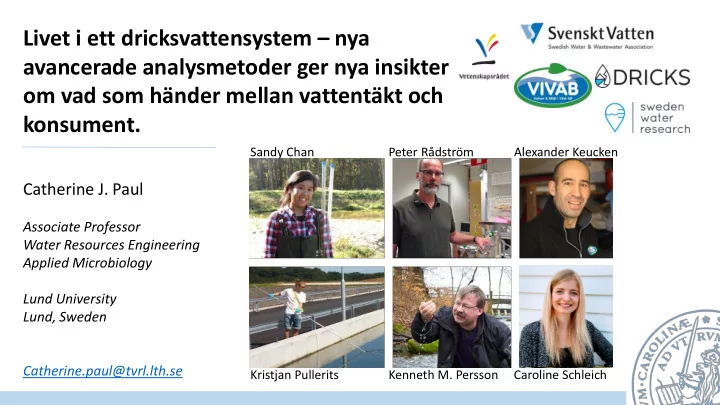

Livet i ett dricksvattensystem – nya avancerade analysmetoder ger nya insikter om vad som händer mellan vattentäkt och konsument. Sandy Chan Peter Rådström Alexander Keucken Catherine J. Paul Associate Professor Water Resources Engineering Applied Microbiology Lund University Lund, Sweden Catherine.paul@tvrl.lth.se Kristjan Pullerits Kenneth M. Persson Caroline Schleich
The microbial ecosystem of drinking water Tomorrow: Sandy Chan Tomorrow: Kristjan Pullerits Adapted from Proctor and Hammes. 2015. Current opinion in biotechnology 33: 87-94.
Next Generation DNA Sequencing 16S rRNA Many DNA sequences Inventory of bacteria bioinformatics
Different source water or treatment plant, different bacteria +GW
Flow cytometry Mälaren Bolmen One bacteria at a time Normaliserat antal bakterier Kranvatten Loka DNA-based, no growing One analysis can give: number of cells number of intact cells overall DNA fingerprint Grön fluorescens Rapid, simple, and potential for online measurements
Deep underground….
This biofilm is constantly interacting with the water Microbial Ecosystem Pipe material* Bacterium from Biofilm biofilm Bacterium from Water/DWTP Tap water (cells/mL) Lund: 200 000 Malmö: 470 000 Varberg: 750 000 Stockholm: 300 000 *not to scale
How do we find out who is in the biofilm? IDEA: Changes after the treatment Look at changes in the cells plant from release from biofilm in the water Too many cells in the water = Not possible to see
IDEA: Installation of UF in Varberg Pipe material* Bacterium from Biofilm biofilm Bacterium from Water/DWTP Tap water (cells/mL) Varberg: 750 000 *still not to scale
Flow cytometry How many cells move into the water? 16SrRNA amplicon Who is moving?
How many bacteria are leaving the biofilm? From the DWTP Before UF: around 750 000 cells/mL After UF: around 2000 cells/mL From the biofilm Before UF: 0.5% After UF: 58%
Water entering the house Before UF, bacteria from treatment plant are the majority After UF, bacteria from the pipe biofilm are the majority (although less)
Who is leaving the biofilm? Single Carbon metabolism Vs .
What is the story at the distribution system scale?
Are these changes due to biofilm? ? And ultimately… What is a good biofilm? And where does it come from?
Keynote speakers Frederik Hammes, EAWAG, Switzerland Isabel Douterelo, University of Sheffield, UK Other confirmed speakers Gang Liu, Oasen and TU Delft, Netherlands Jane Fowler, DTU, Denmark Wilhelm Hijnen, Evides, Netherlands Tarja Pitkänen, National Institute for Health and Welfare, Finland
Recommend
More recommend